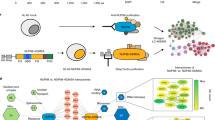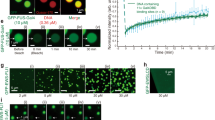Abstract
Mixed lineage leukemia (MLL) fusion proteins are derived from translocations at 11q23 that occur in aggressive subtypes of leukemia. As a consequence, MLL is joined to different unrelated proteins to form oncogenic transcription factors. Here we demonstrate a direct interaction between several nuclear MLL fusion partners and present evidence for a role of these proteins in histone binding. In two-hybrid studies, ENL interacted with AF4 and AF5q31 as well as with a fragment of AF10. A structure–function analysis revealed that the AF4/AF5q31/AF10 binding domain in ENL coincided with the C-terminus that is essential for transformation by MLL-ENL. The ENL/AF4 association was corroborated by GST-pulldown experiments and by mutual coprecipitation. Both proteins colocalized in vivo in a nuclear speckled pattern. Moreover, AF4 and ENL coeluted on sizing columns together with the known ENL binding partner Polycomb3, suggesting the presence of a multiprotein complex. The overexpression of ENL alone activated a reporter construct and a mutational screen indicated the conserved YEATS domain as essential for this function. Overlay and pulldown-assays finally showed a specific and YEATS domain-dependent association of ENL with histones H3 and H1. In summary, our studies support a common role for nuclear MLL fusion partners in chromatin biology.
This is a preview of subscription content, access via your institution
Access options
Subscribe to this journal
Receive 50 print issues and online access
$259.00 per year
only $5.18 per issue
Buy this article
- Purchase on Springer Link
- Instant access to full article PDF
Prices may be subject to local taxes which are calculated during checkout




Similar content being viewed by others
References
Ayton PM and Cleary ML . (2001). Oncogene, 20, 5695–5707.
Bittner CB, Zeisig DT, Zeisig BB and Slany RK . (2004). Eukaryot. Cell, 3, 976–983.
Cairns BR, Henry NL and Komberg RD . (1996). Mol. Cell. Biol., 16, 3308–3316.
Debernardi S, Bassini A, Jones LK, Chaplin T, Linder B, de Bruijn DR, Meese E and Young BD . (2002). Blood, 99, 275–281.
Erfurth F, Hemenway CS, De Erkenez AC and Domer PH . (2004). Leukemia, 18, 92–102.
Ernst P, Wang J, Huang M, Goodman RH and Korsmeyer SJ . (2001). Mol. Cell. Biol., 21, 2249–2258.
Estable MC, Naghavi MH, Kato H, Xiao H, Qin J, Vahine A and Roeder RG . (2002). J. Biomed. Sci., 9, 234–245.
Feng Q, Wang H, Ng HH, Erdjument-Bromage H, Tempst P, Struhi K and Zhang Y . (2002). Curr. Biol., 12, 1052–1058.
Ferrando AA, Armstrong SA, Neuberg DS, Sallan SE, Silverman LB, Korsmeyer SJ and Look AT . (2003). Blood, 102, 262–268.
Garcia-Cuellar MP, Schreiner SA, Birke M, Hamacher M, Fey GH and Slany RK . (2000). Oncogene, 19, 1744–1751.
Garcia-Cuellar MP, Zilles O, Schreiner SA, Birke M, Winkler TH and Slany RK . (2001). Oncogene, 20, 411–419.
Hess JL . (2004). Trends Mol. Med., 10, 500–507.
Krogan NJ, Dover J, Wood A, Schneider J, Heidt J, Boateng MA, Dean K, Ryan OW, Golshani A, Johnston M, Greenblatt JF and Shilatifard A . (2003). Mol. Cell, 11, 721–729.
Le Masson I, Yu DY, Jensen K, Chevalier A, Courbeyrette R, Boulard Y, Smith MM and Mann C . (2003). Mol. Cell. Biol., 23, 6086–6102.
Martin ME, Milne TA, Bloyer S, Galoian K, Shen W, Gibbs D, Brock HW, Slany R and Hess JL . (2003). Cancer Cell, 4, 197–207.
Meijsing SH and Ehrenhofer-Murray AE . (2001). Genes Dev., 15, 3169–3182.
Milne TA, Briggs SD, Brock HW, Martin ME, Gibbs D, Allis CD and Hess JL . (2002). Mol. Cell, 10, 1107–1117.
Milne TA, Martin ME, Brock HW, Slany RK and Hess JL . (2005). Cancer Res., submitted.
Nakamura T, Mon T, Tada S, Krajewski W, Rozovskaia T, Wassell R, Dubois G, Mazo A, Croce CM and Canaani E . (2002). Mol. Cell, 10, 1119–1128.
Nilson I, Reichel M, Ennas MG, Greim R, Knorr C, Siegler G, Greil J, Fey GH and Marschalek R . (1997). Br. J. Haematol., 98, 157–169.
Petruk S, Sedkov Y, Smith S, Tillib S, Kraevski V, Nakamura T, Canaani E, Croce CM and Mazo A . (2001). Science, 294, 1331–1334.
Ross ME, Zhou X, Song G, Shurtleff SA, Girtman K, Williams WK, Liu HC, Mahfouz R, Raimondi SC, Lenny N, Patel A and Downing JR . (2003). Blood, 102, 2951–2959.
Rozenblatt-Rosen O, Rozovskaia T, Burakov D, Sedkov Y, Tillib S, Blechman J, Nakamura T, Croce CM, Mazo A and Canaani E . (1998). Proc. Natl. Acad. Sci. USA, 95, 4152–4157.
Rozovskaia T, Feinstein E, Mor O, Foa R, Blechman J, Nakamura T, Croce CM, Cimino G and Canaani E . (2001). Oncogene, 20, 874–878.
Schreiner S, Birke M, Garcia-Cuellar MP, Zilles O, Greil J and Slany RK . (2001). Cancer Res., 61, 6480–6486.
Shilatifard A, Lane WS, Jackson KW, Conaway RC and Conaway JW . (1996). Science, 271, 1873–1876.
Slany RK, Lavau C and Cleary ML . (1998). Mol. Cell. Biol., 18, 122–129.
So CW and Cleary ML . (2002). Mol. Cell. Biol., 22, 6542–6552.
So CW and Cleary ML . (2003). Blood, 101, 633–639.
So CW and Cleary ML . (2004). Blood, 104, 919–922.
So CW, Lin M, Ayton PM, Chen EH and Cleary ML . (2003). Cancer Cell, 4, 99–110.
Srinivasan RS, Nesbit JB, Marrero L, Erfurth F, LaRussa VF and Hemenway CS . (2004). Leukemia, 18, 1364–1372.
Sutton A, Shia WJ, Band D, Kaufman PD, Osada S, Workman JL and Sternglanz R . (2003). J. Biol. Chem., 278, 16887–16892.
Wood A, Schneider J, Dover J, Johnston M and Shilatifard A . (2003). J. Biol. Chem., 278, 34739–34742.
Yeoh EJ, Ross ME, Shurtleff SA, Williams WK, Patel D, Mahfouz R, Behm FG, Raimondi SC, Relling MV, Patel A, Cheng C, Campana D, Wilkins D, Zhou X, Li J, Liu H, Pui CH, Evans WE, Naeve C, Wong L and Downing JR . (2002). Cancer Cell, 1, 133–143.
Yokoyama A, Wang Z, Wysocka J, Sanyal M, Aufiero DJ, Kitabayashi I, Herr W and Cleary ML . (2004). Mol. Cell. Biol., 24, 5639–5649.
Zeisig BB, Garcia-Cuellar MP, Winkler TH and Slany RK . (2003a). Oncogene, 22, 1629–1637.
Zeisig BB, Milne T, Garcia-Cuellar MP, Schreiner S, Martin ME, Fuchs U, Borkhardt A, Chanda SK, Walker J, Soden R, Hess JL and Slany RK . (2004). Mol. Cell. Biol., 24, 617–628.
Zeisig BB, Schreiner S, Garcia-Cuellar MP and Slany RK . (2003b). Leukemia, 17, 359–365.
Zhang H, Richardson DO, Roberts DN, Utley R, Erdjument-Bromage H, Tempst P, Cote J and Cairns BR . (2004). Mol. Cell. Biol., 24, 9424–9436.
Acknowledgements
We wish to thank B Young for the AF10 cDNA and Guoliang Xi for sharing unpublished results. We are grateful to Renate Zimmermann for technical assistance, and Georg Fey for continuous support. This work was supported by DFG Grants SL27/6-2 and SFB473/D2 to RKS, NIH Grants CA78815 and CA92251 to JLH, and by a stipend of GRK592 to DTZ. RKS is a recipient of a Ria Freifrau-von-Fritsch Stiftung career development award.
Author information
Authors and Affiliations
Corresponding author
Rights and permissions
About this article
Cite this article
Zeisig, D., Bittner, C., Zeisig, B. et al. The eleven-nineteen-leukemia protein ENL connects nuclear MLL fusion partners with chromatin. Oncogene 24, 5525–5532 (2005). https://doi.org/10.1038/sj.onc.1208699
Received:
Revised:
Accepted:
Published:
Issue Date:
DOI: https://doi.org/10.1038/sj.onc.1208699
Keywords
This article is cited by
-
The ENL YEATS epigenetic reader domain critically links MLL-ENL to leukemic stem cell frequency in t(11;19) Leukemia
Leukemia (2023)
-
CRISPR–ChIP reveals selective regulation of H3K79me2 by Menin in MLL leukemia
Nature Structural & Molecular Biology (2023)
-
Potent, p53-independent induction of NOXA sensitizes MLL-rearranged B-cell acute lymphoblastic leukemia cells to venetoclax
Oncogene (2022)
-
Automated CUT&Tag profiling of chromatin heterogeneity in mixed-lineage leukemia
Nature Genetics (2021)
-
ENL: structure, function, and roles in hematopoiesis and acute myeloid leukemia
Cellular and Molecular Life Sciences (2018)



